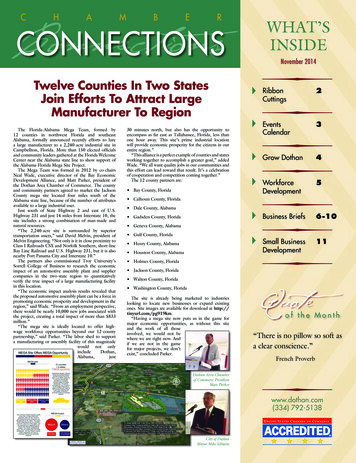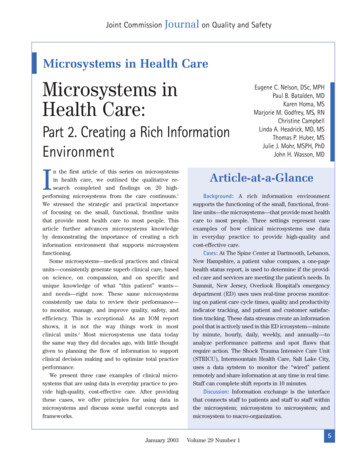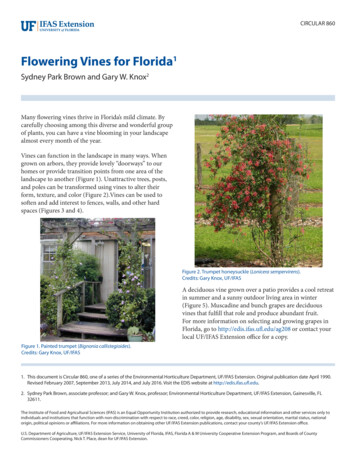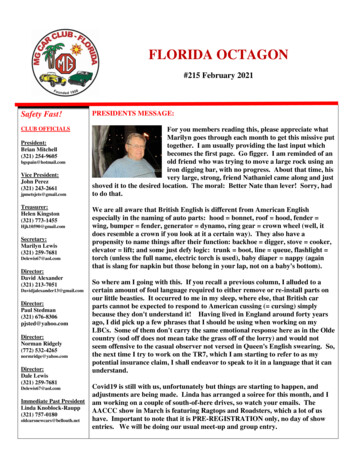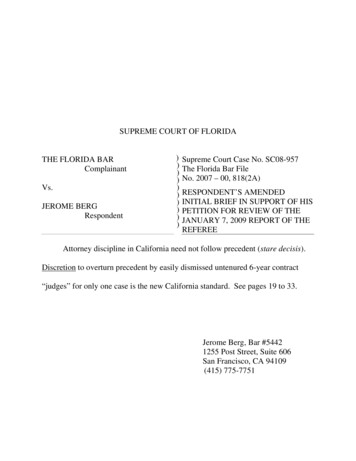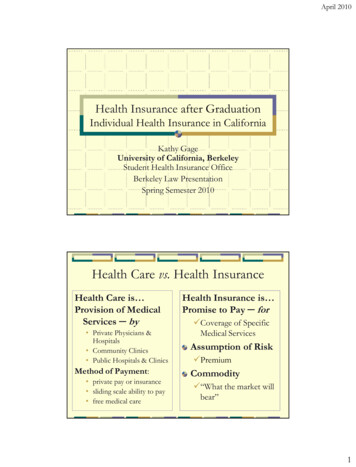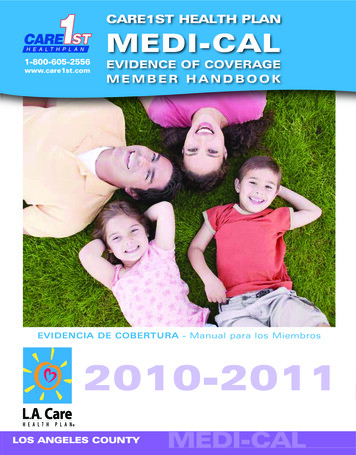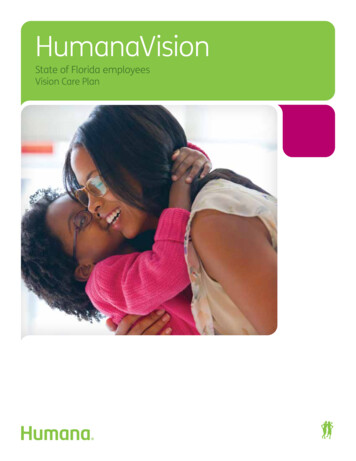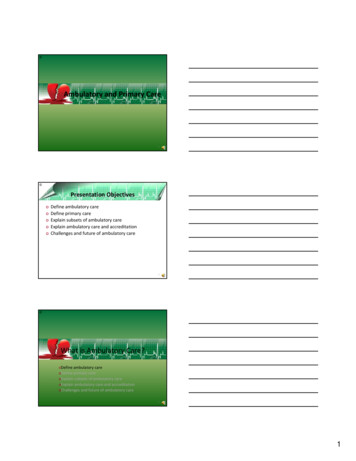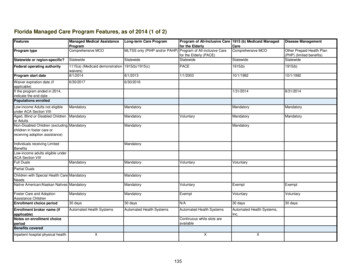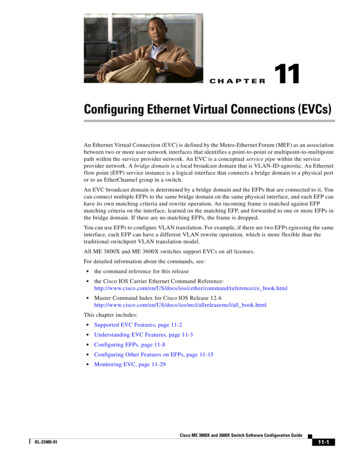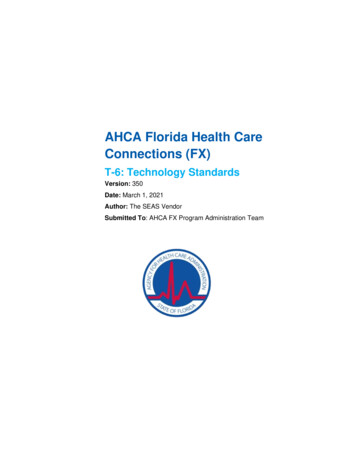
Transcription
AHCA Florida Health CareConnections (FX)T-6: Technology StandardsVersion: 350Date: March 1, 2021Author: The SEAS VendorSubmitted To: AHCA FX Program Administration Team
Revision : Technology Standards initial draft versionMike Griffiths3/26/2018002T-6: Technology Standards second draft 6: Technology Standards second draft versionMike Griffiths/PaulMoore05/02/2019101T-6: Technology Standards annual refresh draftversionMike Griffiths/PaulMoore/JonHenderson6/11/2019102T-6: Technology Standards annual refresh draftresponseMike Griffiths7/18/2019200T-6: Technology Standards annual refresh finalapprovalCarol Williams1/7/2020201T-6: Technology Standards Quarterly refresh draftMike Griffiths1/27/2020225T-6: Technology Standards quarterly refresh finalapprovalEric Steinkuehler5/13/2020226T-6: Technology Standards Quarterly refreshUpdates to TSRM and TSRG – Additions ofCherwell, Open API 3.0, CMDB, CMSInteroperability and Patient Access final ruleJoanna ReddingSteve Ruszkowski5/19/2020300T-6: Technology Standards quarterly refresh finalapprovalPalmer White1/21/2021301T-6: Technology Standards Quarterly refresh draftSteve Ruszkowski3/1/2021350T-6: Technology Standards approved final versionCarol WilliamsModifications to this artifact must be made in accordance with the FX Artifact ManagementStandards.Agency for Health Care AdministrationFlorida Health Care Connections (FX)Page iiT-6: Technology Standards
Quality Review HistoryDATEREVIEWERCOMMENTS3/2/2018Sean GibbsQuality Assurance Review4/2/2018Sean GibbsQuality Assurance Review4/11/2019Mary Lindsay RyanQuality Assurance Review1/6/2020Eric SteinkuehlerQuality Assurance Review12/3/2020Carol WilliamsQC reviewAgency for Health Care AdministrationFlorida Health Care Connections (FX)Page iiiT-6: Technology Standards
Table of ContentsSection 1 Introduction . 11.1Background. 11.2Purpose . 11.3Scope Statement . 11.4Goals and Objectives . 21.5Referenced Documents . 2Section 2 Roles and Responsibilities . 4Section 3 Technology Standards Reference Model . 53.1TSRM Service Component List . 53.2TSRM Service Component List Parts . 53.2.1Service Area . 53.2.2Service Category . 63.2.3Service Component . 63.2.4Service Component List – Extract . 63.3Technology Standards Reference Model Maintenance . 63.3.1Technology Standards Reference Model Maintenance Procedures . 6Section 4 Technology Standards Reference Guide . 74.1Guide Structure. 84.1.1Domain . 94.1.2Area . 94.1.3Category . 94.1.4Project Life Cycle . 104.1.5Standard Number . 104.1.6Standard Name. 104.2Technology Standards Reference Guide Maintenance . 104.2.14.3Technology Standards Reference Guide Maintenance Procedures . 10Technology Standards Communications and Compliance . 104.3.1Technology Standards Communication, Support, Compliance, and ComplianceReporting Procedures . 11Agency for Health Care AdministrationFlorida Health Care Connections (FX)Page ivT-6: Technology Standards
Section 5 Supporting Documents . 12Table of ExhibitsExhibit 2-1: Roles and Responsibilities . 4Exhibit 3-1: Service Component List Example . 5Exhibit 3-2: Service Component Example . 6Exhibit 4-1: TSRG Standards Hierarchy Example . 8Exhibit 4-2: TSRG Structure . 8Agency for Health Care AdministrationFlorida Health Care Connections (FX)Page vT-6: Technology Standards
SECTION 11.1INTRODUCTIONBACKGROUNDThe Florida Agency for Health Care Administration (AHCA or Agency) is adapting to thechanging landscape of healthcare administration and increased use of the Centers forMedicare and Medicaid Services (CMS) Medicaid Information Technology Architecture (MITA)to improve the administration and operation of the Florida Medicaid Enterprise. The currentFlorida Medicaid Enterprise is complex; it includes services, business processes, datamanagement and processes, technical processes within the Agency, and interconnections andtouchpoints with systems necessary for administration of the Florida Medicaid program thatreside outside the Agency. The future of the Florida Medicaid Enterprise integration is to allowthe Agency to secure services that can interoperate and communicate without relying on acommon platform or technology.The Florida Medicaid Management Information System (FMMIS) has historically been thecentral system within the Florida Medicaid Enterprise; functioning as the single, integratedsystem for claims processing and information retrieval. As the Medicaid program has grownmore complex, the systems needed to support the Florida Medicaid Enterprise have grown innumber and complexity.The Medicaid Enterprise System (MES) Procurement Project was re-named Florida HealthCare Connections (FX) in the summer of 2018. FX is a multi-year transformation to modernizethe current Medicaid technology using a modular approach, while simultaneously improvingoverall Agency functionality and building better connections to other data sources andprograms.1.2PURPOSEStandardizing the vocabulary and application of technology standards in the implementationand use of technology improves the efficiency, data sharing, and reuse of technology andbusiness processes. This deliverable establishes and populates a framework for a commontechnology vocabulary and communication of relevant and applicable standards for technologycomponents. The Technology Standards Reference Model (TSRM) is the common technologyvocabulary that organizes, and groups related technology components standardizing thenames and descriptions of those components. The Technology Standards Reference Guide(TSRG) is a repository of standards relevant to technology components that identifies andprioritizes the relevance of specific technology standards in the enterprise. Together these twocomponents make up the FX technology standards that help technology stakeholders identifyopportunities, and implement, operate, and continuously improve the FX System.1.3SCOPE STATEMENTThe Technology Standards Artifacts defined in this deliverable integrate MITA 3.0, FederalEnterprise Architecture (FEA), Agency, and other standards to provide a more comprehensiveopen system environment. This approach allows for a more mature framework while maintainingcompliance with MITA 3.0.Agency for Health Care AdministrationFlorida Health Care Connections (FX)Page 1 of 12T-6: Technology Standards
The initial version of this deliverable focused on the broad standards directly relevant to FXinitial procurements. The current deliverable assumes the definition of additional technologycomponents and standards as FX projects’ focus shifts to modernization and procurements ofother types of technology, expanded enterprise wide participation, and ongoing standardsmaturation.1.4GOALS AND OBJECTIVESGoal 1 – The primary goal of this deliverable is to establish the MITA compliant TSRG andTSRM. This goal will be accomplished by achieving the following objective:Objective #1 – The current MITA 3.0 Technology Standards methodology will be used inconjunction with other generally accepted methodologies such as Federal EnterpriseArchitecture (FEA) and The Open Group Architecture Forum (TOGAF) to provide a morerobust Florida Medicaid specific Technology Standards Framework.Goal 2 – Another goal of this deliverable is to establish a process to maintain the TSRG andTSRM. This goal will be accomplished by achieving the following objective:Objective #2 – As technology standards evolve so must the artifacts that support thosetechnology standards. This deliverable provides How To guidance (as attached documents)that describe systematic processes to maintain the TSRG and TSRM.1.5REFERENCED DOCUMENTSBelow is a list of documents referenced in the development of this deliverable including anyother project plans and or documentation, Federal or State Authorities, quality standards, Stateartifacts, and other deliverables relevant to this document.Governmental agencies and professional associations frequently update, move, or removedocuments causing broken links. Therefore, external links to the listed documents are notprovided. Documents can potentially be located by pasting the bolded headings into a webbrowser (e.g., Google) and selecting the most similar document title, or typing into a webbrowser the organization’s name and using the organization’s search tool to find the document. Office of the National Coordinator (ONC) Interoperability Standards Advisory(ISA) The ONC designed the ISA to provide clarity, consistency, and predictability forthe public regarding the standards used for health information technology (IT)interoperability purposes. Medicaid Information Technology Architecture (MITA) MITA is intended to fosterintegrated business and IT transformation across the Medicaid Enterprise to improvethe administration of the Medicaid program. NOTE: The MITA 3.0 contains bothstandards and a framework.The following two architecture frameworks were used in conjunction with MITA 3.0 to createthe FX TSRM:Agency for Health Care AdministrationFlorida Health Care Connections (FX)Page 2 of 12T-6: Technology Standards
Federal Enterprise Architecture (FEA) Wikipedia The Federal EnterpriseArchitecture framework is the United States’ reference enterprise architecture for thefederal government. It provides a united approach for the integration of strategic,business, and technology management as part of organization design and performanceimprovement. Foundation Architecture: Technical Reference Model (TOGAF) The TOGAF framework is the global standard for Enterprise Architecture. The Open GroupArchitecture Forum, which includes more than 200 enterprises, develops and maintainsthe TOGAF standards and publishes new versions at regular intervals.Agency for Health Care AdministrationFlorida Health Care Connections (FX)Page 3 of 12T-6: Technology Standards
SECTION 2ROLES AND RESPONSIBILITIESThis section identifies the roles and responsibilities for the primary stakeholders involved withthis deliverable.ROLERESPONSIBILITY SEAS Technical Architect FX Technology StandardsCommittee FX Stakeholder Organizations FX Project Owners Identifies the technology or software required to improve or extendthe life of any given TSRM Service Component.Identifies the evolving technology standards necessary to improve theEnterprise.Reviews and proposes new, updates, and retirement of technologycomponents and standards to the FX Technology StandardsCommittee.Maintains the TSRG and TSRM. The Agency shall determine a timeperiod in which to look at and evaluate any new standards or servicecomponents.Extracts TSRM and TSRG artifacts for use in vendor procurements.Identifies Required and Conditional Technology Standards forinclusion in ITNs during FX module development.Identifies risks of adopting new technologies and standards.Prepares an assessment of risks related to proposed additions orchanges to standards.Conducts impact analysis of existing projects and procurements ofproposed additions or changes to standards.Creates specific rules to help identify new technologies andstandards.Reviews proposed new technology standards.Recommends for approval or denies new TSRM and TSRG listentries.Committee will evaluate risks (e.g., additional costs or limited vendorparticipation) related to standards and make approvalrecommendations or communicate and escalate standardsrecommendations to FX implementation TeamReviews and as appropriate may align technology solutions with FXtechnology standards to improve Medicaid program outcomes.Contributes recommendations for TSRM entries and standards toimprove integration, consistency, and coordination.Communicates using the technology vocabulary in the TSRM inproposing, discussing, and implementing technology for the FXSystem.Identifies and understands technology standards applicable toimplementation of FX projects using vendor provided technology orsoftware.Exhibit 2-1: Roles and ResponsibilitiesAgency for Health Care AdministrationFlorida Health Care Connections (FX)Page 4 of 12T-6: Technology Standards
SECTION 3TECHNOLOGY STANDARDS REFERENCE MODELThe TSRM is a component-driven technical framework that provides a foundation to categorizethe service components and technologies used now and in the future by the enterprise. Thisdeliverable presents the components in the TSRM as a searchable list structure in the FXProjects Repository (i.e., FX Home Standards and Plans Technology FX TechnologyStandards).3.1TSRM SERVICE COMPONENT LISTThe TSRM Service Component List is a custom SharePoint list residing in the FX ProjectsRepository (FXPR). Exhibit 3-1: Service Component List Example depicts a screen shotview of a sample page of the list. The list has multiple views for displaying the data in differentcontext.Exhibit 3-1: Service Component List Example3.2TSRM SERVICE COMPONENT LIST PARTSThe following are the elements found in an TSRM Repository entry.3.2.1 SERVICE AREAService Area is the highest technical layer within the TSRM. It represents an aggregate ofService Components for the use in construction, exchange, and delivery of broad business ortechnological functions.Agency for Health Care AdministrationFlorida Health Care Connections (FX)Page 5 of 12T-6: Technology Standards
3.2.2 SERVICE CATEGORYService Category is the second technical layer of the model. Service Category further classifiescommon technologies with respect to the business or technological functions they serve.3.2.3 SERVICE COMPONENTService Component is the lowest technical layer of the model. It defines discrete technicalcomponents or processes within defined Service Categories and Service Areas.Exhibit 3-2: Service Component Example3.2.4 SERVICE COMPONENT LIST – EXTRACTAttachment C – Technology Standards Reference Model contains an extract from the TSRMfrom the FXPR that is stored in Microsoft (MS) Excel format (i.e., FX Home Standards andPlans Technology FX Technology Standards). This file contains the content as of the dateof deliverable submission.3.3TECHNOLOGY STANDARDS REFERENCE MODEL MAINTENANCEThe TSRM Service Component List is meant to be a living document. The TSRM may evolvethrough successive updates, expand as needed, and serve a different purpose over time. Forthis to occur, a mechanism for maintenance must exist. A How To document has been createdto serve this purpose.3.3.1 TECHNOLOGY STANDARDS REFERENCE MODEL MAINTENANCE PROCEDURESAttachment A – How to Maintain the TSRM List is a MS Word document that describes theprocedures to maintain content in the Technology Standards Reference Model (i.e., FX Home Standards and Plans Technology FX Technology Standards).Agency for Health Care AdministrationFlorida Health Care Connections (FX)Page 6 of 12T-6: Technology Standards
SECTION 4TECHNOLOGY STANDARDS REFERENCE GUIDEA technology standard is an established norm or requirement for technical systems. Standardsare usually a formal document that establishes uniform engineering or technical criteria,methods, processes, and practices. The TSRG is a collection of technology standardsapplicable to the administration and operation of the enterprise and the future state enterprise.The standards are divided into three compliance levels: REQUIRED (Technology Standards that must be adhered to by FX Project Owners(vendors) as applicable to their project). CONDITIONAL (Technology Standards that FX Project Owners (vendors) must complywith if applicable). REFERENCE (Technology Standards that serve as informational to possibly adhere toor comply with complement/supplement other standards).Content in the TSRG is in a MS Excel spreadsheet (i.e., FX Home Standards and Plans Technology FX Technology Standards), which adheres to the MITA Framework. The TSRGis a collection of technology standards that originate from many sources.Exhibit 4-1: TSRG Standards Hierarchy shows the types of organizations that are sources ofrelevant technology standards. Often standards of different organizations are aligned andconsistent. Higher-level organizations may adopt lower-level standards or provide guidancethat is more specific to the enterprise, organization, or system. In some cases, standards mayconflict, or an organization may provide guidance that certain standards are waived or notapplicable. The TSRG seeks to help stakeholders understand not only the universe ofapplicable standards, but also provides a framework and guidance to prioritize and resolvepotential conflicting standards. Projects are to follow applicable standards about a topic byviewing standards based on the hierarchy and considering the guidance from the highest levelof the hierarchy that is applicable to the project. If Agency guidance existed that overrodeState, or lower levels in the hierarchy, projects would follow the Agency guidance. For a projectfor which CMS/ONC guidance was not relevant, standards from that level of the hierarchywould not be applicable.Agency for Health Care AdministrationFlorida Health Care Connections (FX)Page 7 of 12T-6: Technology Standards
Exhibit 4-1: TSRG Standards Hierarch
Cherwell, Open API 3.0, CMDB, CMS Interoperability and Patient Access final rule Joanna Redding Steve Ruszkowski 5/19/2020 300 T-6: Technology Standards quarterly refresh final approval Palmer White 1/21/2021 301 T-6: Tech
